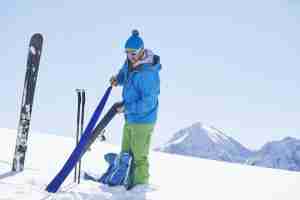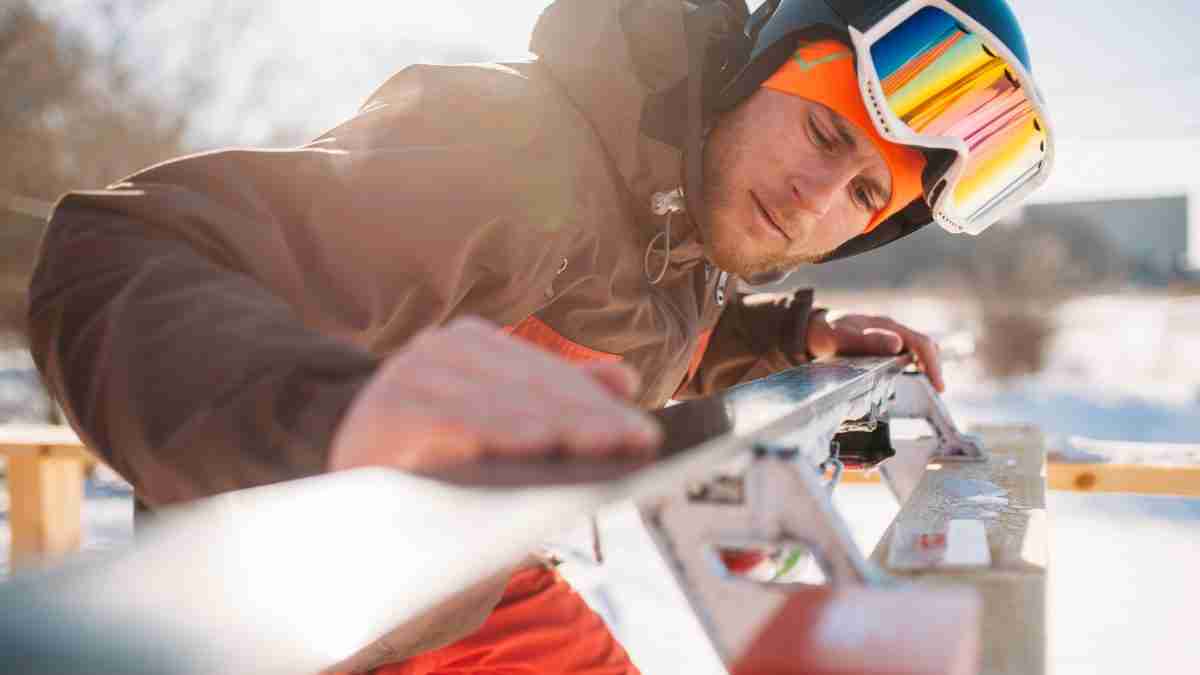Do you want to hit the slopes this winter but are feeling a bit unsure or intimidated? Skiing can often be intimidating for those who have never done it before.
If you’re an adrenaline-seeker looking for new thrills, skiing is the perfect sport for you. Whether you’re an experienced skier or a beginner, there are plenty of tips and tricks to get you out on the slopes in no time.
To help make your skiing experience as enjoyable and successful as possible here is some useful advice from experts on how to improve your technique, enjoy the sport, and stay safe while doing it. Learn how to dress and move effectively so that you can make the most of every ski session.
You’ll Learn in this Article:
- Skiing is an exciting and rewarding sport once you understand the basics techniques as well as dress properly.
- It is important to understand your ski equipment and have the correct stance when hitting the slopes.
- Gravity plays a key factor in skiing, so it is vital to learn how to use it properly in order to maximize performance.
10 Step-By-Step Beginner Skiing Techniques to Master
Skiing is a great way to enjoy the outdoors and get some exercise. As you become more experienced, skiing can become even more enjoyable as you improve your skills. The best skiers never stop learning and strive for mini breakthroughs in their performance. To help you become a better skier and make the most of your time on the snow, here are 10 helpful tips.
1. Commit 100%
- Commit 100%: Skiing is a sport that requires commitment and focus. Before you hit the slopes, make sure you are mentally prepared to commit 100% to the experience. This means having the right attitude and being willing to push yourself out of your comfort zone. It also means taking the time to learn proper techniques and safety protocols so that you can ski with confidence. When you commit 100 %, you’ll be able to make the most of your time on the slopes
2. Fix your stance
Having the correct stance is essential for skiing maneuvers, as it helps maintain balance and control over the skis. To achieve a balanced stance, move the feet to keep them over the arch of the foot while keeping the upper body still. Advanced skiers should look for a stable base of support with three points of contact on the ground and pull up the toes so that the shin engages with the front of the boot.
The type of terrain can also affect how you should adjust your stance. Moguls require a narrower stance to fit in the outline and hit each bump together, while ice and steeps can be easier with a wider stance for stability. Powder requires a narrow stance to help skis float higher in the snow, whereas loose, choppy snow can cause a loss of balance when skiing. To combat this, skiers should adjust their stance by focusing on lowering the contact point in the boot to the second buckle down the strap.
3. Understand your ski equipment
Skiing is a great way to get out and enjoy the winter weather, but it’s important to understand your ski equipment in order to get the most out of your experience. Skis should be facing the direction of travel in order to ensure a smooth ride, and boots should fit snugly and respond immediately to leg movements. Advanced skiers should choose the right ski width for their needs; short skis are easy to turn and spin, while longer skis are more stable at high speeds. Flexible skis are forgiving and maneuverable in the bumps, while stiffer skis hold carved turns at high-edge angles. Skiing with a well-fitted boot will add to the performance, but be careful not to rely too heavily on it for balance.
When choosing skis, there are several factors to consider such as width underfoot, turning radius, and length. Different types of skis are better suited for different conditions; for example, wider skis provide more float in powder, while narrower skis are better for carving on groomers.
4. Understand gravity in skiing
Gravity plays an important role in skiing, and understanding how to use it can help improve technique. As the skis turn from across the hill into the fall line, they pick up speed and run smoothly. This is due to gravity pulling them down the slope. When turning out of the fall line and back across the hill, use momentum to slow down. This will help you maintain control and stay on your feet.
When skiing on icy slopes, keep your speed down and use your edges to stay in control. The edges of your skis should be able to grip the ice so that you don’t slip or slide out of control. When skiing on soft snow, the skis will have more control as the edges can dig into the snow for better traction. It’s also important to keep your legs close together at all times when skiing in order to maintain balance and stability. By understanding how gravity works with skiing, you can become a better skier and enjoy a safe experience on the slopes.
5. Focus on your outside ski
Focusing on the outside ski is an important part of the skiing technique. To do this, you need to lighten and flex the inside leg to allow camber back into the ski. This will help you soften your inside body and allow it to be pulled over the balance point on the outside foot. You should also increase the edge angle by bending the inside leg and allowing your knee to float up toward your armpit. Additionally, you should allow your outside leg to bend while still balanced on it. As you move down the mountain, gradually shift weight from one foot to the other when skis are flat and step onto a new outside ski as the next turn begins, timing it so there is no delay.
To help improve your skiing technique, strength training exercises can be done at home or in a gym that will help get you fit for skiing. There are also quick exercises that can be done at home, in the gym, or even in an office setting that can help improve flexibility and prevent injuries.
6. Mix it up and vary the intensity
Mixing up the intensity of your skiing is essential to becoming a better skier. It’s important to spend time in your comfort zone, as this allows you to refine your technique and make small changes that can have a big impact on your performance. This could include working on specific drills or exercises that help you improve your balance, control, and agility.
At the same time, it’s also important to push yourself out of your comfort zone and into more challenging terrain. This will help you learn how to recover from mistakes and make micro-adjustments in order to stay safe while skiing at higher speeds. By varying the intensity of your skiing, you can become a more well-rounded skier who is comfortable in all types of conditions.
7. Make drills count
Drills are an important part of skiing and should be tailored to address any weaknesses in technique. When doing drills, it is important to pay attention to the feelings associated with them and vary the speed and turn shape when comfortable. This will help you transition back to normal skiing while keeping the new feeling and trying to achieve the same outcome.
One drill that can be used to improve technique is holding poles horizontally at chest level with elbows straight and locked. From this position, reach forward and laterally to feel pressure on the inside little toe. This helps initiate turns while also leveling shoulders for a more balanced stance. Doing this drill regularly can help improve your overall skiing technique, making sure you get the most out of each run.
8. Ski with flow
Skiing with the flow is a great way to improve your skiing technique and make it more enjoyable. It involves looking ahead and using pole plants and rhythm to create smoother movements. By letting the skis run flat between each turn, you can link everything together and find your line faster. This technique also helps you carry speed when necessary and finish a turn coming across an edge.
When skiing on icy slopes, it is important to keep your speed down and use your edges to maintain control. In soft snow conditions, the skis will have more control as the edges can dig into the snow well. To navigate moguls, keep your legs close together and use them to initiate turns. With practice, these techniques will help you ski with the flow and enjoy a smooth ride down the mountain.
9. Know your own learning style
Understanding one’s own learning style is essential to make the most of time and reaching goals. It can help tailor training and provide insight into where to go next. External feedback is also important in order to stay on track and ensure progress. Analytical tools, lessons from professionals, and ski instructors can all be beneficial in helping individuals understand their own learning styles.
Skiing is a great way to learn about one’s own learning style while having fun at the same time. Professional ski lessons are the best way to reach your potential and enjoy skiing, as ski instructors will teach you the correct techniques and take you to the most appropriate slopes for your level of experience. The best ski coaches in Whistler have years of experience teaching skiing and enjoy it just as much as they do skiing themselves. With their help, individuals can gain a better understanding of their own learning style while enjoying the beautiful mountains.
10. Check in regularly
Regularly checking in on progress is an important part of achieving any goal. It allows us to measure our progress and make adjustments as needed. This can be done manually, or with the help of analytical tools like Carv. Carv provides detailed insights into how far you have come and what needs to be done next. It also helps you set realistic goals for yourself and track your progress over time.
Professional lessons can also provide guidance on where to go next when it comes to achieving your goals. A professional coach or mentor can help you identify areas that need improvement and provide strategies for overcoming obstacles. They can also offer advice on how to stay motivated and focused on the task at hand. With regular check-ins, you will be able to stay on track with your goals and make sure that you are making steady progress toward them.

What type of skis should a beginner use?
When it comes to choosing the right skis for a beginner, there are several factors to consider. The type of ski you choose will depend on your skill level, body type, and skiing goals.
For starters, it is important to select a ski that is appropriate for your skill level. Beginners should look for skis that are wide and short in length. This will provide more stability and control while learning the basics. It is also important to choose a ski that is lightweight and easy to maneuver.
Beginners should also consider their body type when selecting skis. Skis come in different widths and lengths, so it is important to find one that fits your body size and weight. Finally, it is important to think about your skiing goals. If you plan to ski in powder, you may want to look for a wider ski that is better suited for deep snow. If you plan to ski on groomed runs, a narrower ski may be more appropriate.
How many days of skiing are needed to become proficient?
The amount of time it takes to become proficient at skiing varies from person to person. Generally speaking, it can take anywhere from a few days to a few weeks of skiing before you start to feel comfortable on the slopes.
If you are a beginner skier, it is important to start off slowly and build up your skills gradually. Start by taking lessons with an experienced instructor who can help you learn the basics and build your confidence. Once you have a good understanding of the fundamentals, you can start to explore different terrain and challenge yourself.
It is also important to practice regularly in order to become proficient. The more time you spend on the slopes, the better your skills will become. With dedication and practice, it is possible to become an advanced skier in as little as a few weeks.
What safety tips should first-time skiers consider?
If you’re a first-time skier, safety should be your top priority. Here are some tips to help keep you safe on the slopes:
- Wear a Helmet: Wearing a helmet is one of the most important safety precautions for skiing and snowboarding. Make sure your helmet fits properly and is certified by the American Society for Testing and Materials (ASTM).
- Dress Appropriately: Make sure you dress for the weather and wear layers that can be easily removed if you get too warm. Wear waterproof and windproof clothing to protect against the elements.
- Check Your Equipment: Before hitting the slopes, make sure your skis or snowboard are in good condition and properly adjusted for your size and weight.
- Know Your Ability Level: It is important to ski within your ability level. Start on easy slopes and work your way up as you gain experience and confidence. Don’t attempt any terrain that is beyond your skill level, as this can be dangerous.
- Be Aware of Your Surroundings: Pay attention to other skiers and snowboarders around you, and give them plenty of space. Also, be aware of any potential hazards, such as trees, rocks, and other obstacles.
- Follow the Ski Patrol: Always obey the ski patrol’s instructions and follow all posted signs and warnings.
- Take Breaks: Take breaks when you need them to rest and refuel. This will help keep you safe by preventing fatigue and exhaustion.
- Stay Hydrated: Make sure to stay hydrated while skiing by drinking plenty of water throughout the day.
- Know the Signs of Hypothermia: Hypothermia is a serious condition that can occur when you are exposed to cold temperatures for too long. Be aware of the signs, which include shivering, confusion, and slurred speech. If you or someone else exhibits these symptoms, seek medical attention immediately.
- Wear Sunscreen: Even on cloudy days, UV rays can still cause sunburns. Make sure to wear sunscreen with SPF 30 or higher and reapply every two hours.
Wrapping Up Best Skiing Tips
Skiing is a great way to have fun and stay active in the winter months. However, it is important to take safety precautions to ensure you have a safe and enjoyable experience. Follow these tips and you’ll be sure to have a great time on the slopes.
Adam Anderson
Related posts
Hot Topics


